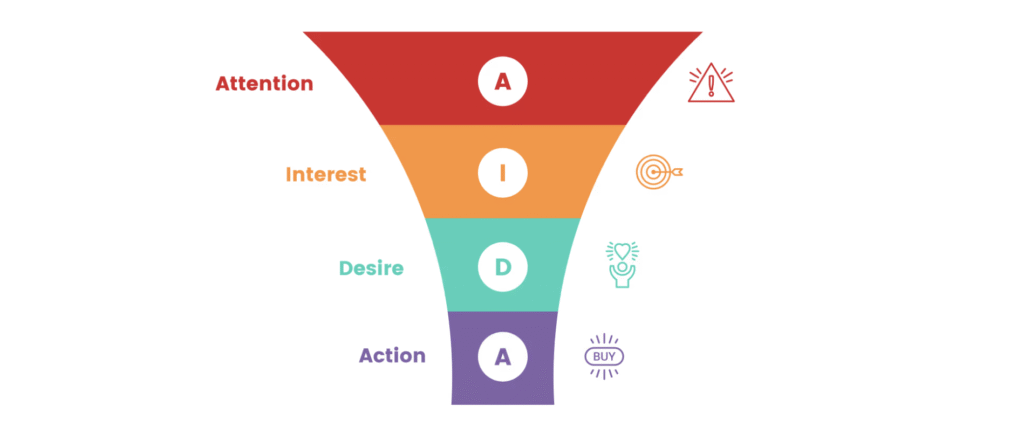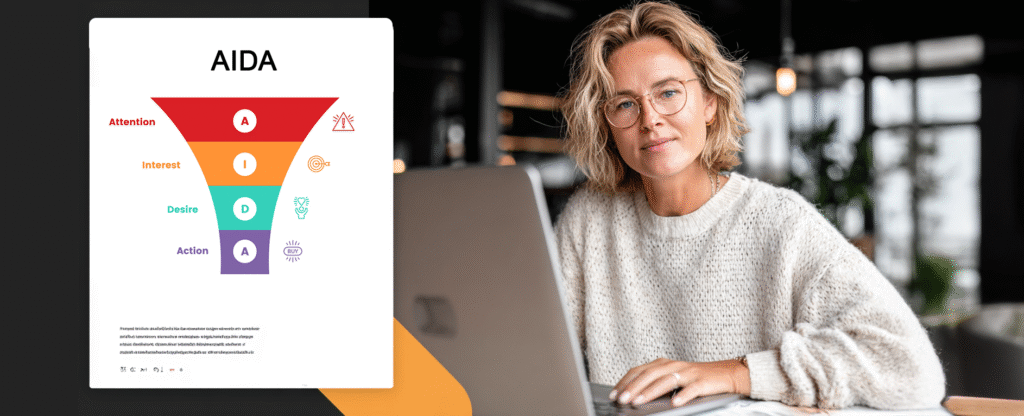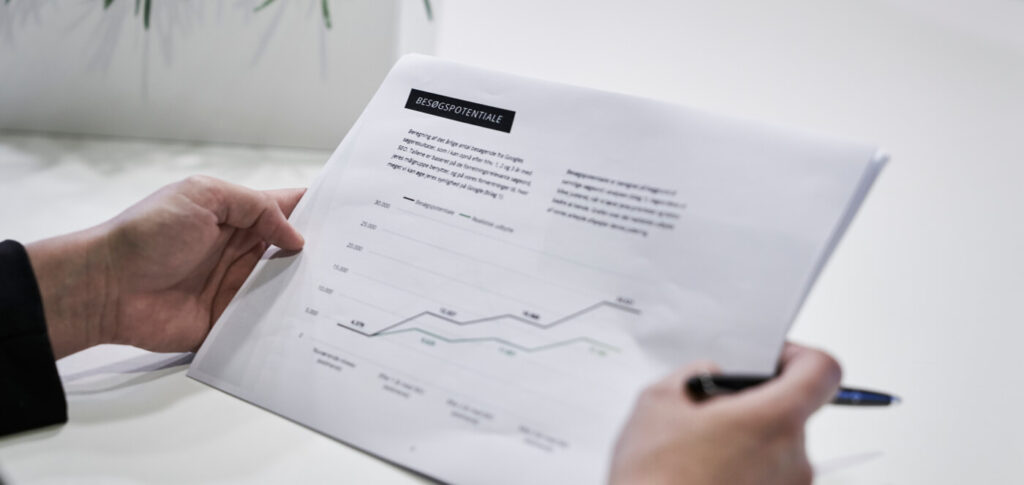Content
- Introduction to the AIDA model
- The four phases of the AIDA model
- Practical use of the AIDA model
- Implementation of AIDA
- Frequently asked questions
- AI-powered AIDA analysis
Introduction to the AIDA model
What is the AIDA model?
The AIDA model is a marketing model that describes the four stages a customer goes through from first contact with your brand to final purchase: Attention, Interest, Desire and Action. The model was developed in 1898 by American advertising man Elias St. Elmo Lewis and is still used today as the foundation for effective marketing communication. For Danish B2B companies, AIDA provides a clear structure to guide potential customers through the buying journey in a noisy digital landscape.
In this guide, you'll get an in-depth understanding of each phase of the AIDA model, concrete examples from Danish B2B companies, and actionable strategies to implement the model in your own marketing efforts. You'll learn how to create awareness, build interest, develop desire and drive action - all adapted to modern B2B marketing in 2025.
What does AIDA stand for in marketing?
AIDA stands for Attention, Interest, Desire and Action. These four letters represent the sequential stages a potential customer goes through in the buying process. Attention is about capturing attention in a crowded market. Interest is about creating engagement and curiosity. Desire is about transforming interest into an active desire to buy. Action is about facilitating the actual purchase or conversion.
Each phase requires different tactics, content types and channels. A potential customer in the awareness phase needs educational content, while a customer in the action phase needs clear calls to action and risk mitigation. By understanding which stage your potential customers are in, you can tailor your message and significantly increase conversion rates.
Who invented the AIDA model and when?
The AIDA model was developed by American advertising man Elias St. Elmo Lewis in 1898. Lewis described the model in the context of selling life insurance and the role of advertising in the buying process. He observed that successful sales presentations always followed a certain pattern: first capture attention, then arouse interest, then create desire and finally get the customer to act.
The model has survived for over 125 years because the fundamental psychological principles behind it remain valid. Although buying behavior has changed dramatically since 1898 - from physical stores to digital platforms, from print ads to AI-powered search - people still need to have their attention captured, their interest piqued, their desire stimulated and their action facilitated. This makes AIDA a timeless model that can be adapted to any era and any medium.
What are the four phases of the AIDA model?
The four phases of the AIDA model are Attention, Interest, Desire and Action. Each phase represents a step in the customer's psychological journey from unconsciousness to purchase. The stages are sequential, meaning you need to master one stage before you can move the customer to the next. A potential customer who hasn't had their attention captured will never make it to the interest stage.
The four phases of AIDA are:

- Attention: Capture customer attention through relevant, surprising or problem-solving content.
- Interest (interest): Drive engagement by demonstrating relevance and value to the customer's specific situation.
- Desire: Transform interest into desire through value propositions, social documentation and risk mitigation.
- Action (handling): Facilitate the purchase with clear calls to action, friction reduction and immediate value.
In the following sections, we go through each phase in detail with concrete examples, tactics and best practices from Danish B2B companies.
The four phases of the AIDA model
How do you create attention in the AIDA model?
Attention is created by being relevant, surprising or solving an urgent problem for your target audience. In the B2B context, this means breaking through to decision makers who are bombarded with hundreds of marketing messages daily. The most effective tactics to create awareness are thought-provoking content (original research, in-depth analysis), provocative questions that challenge the status quo, visual disruption tactics (infographics, data visualizations) and strategic channel selection where your target audience is already active.
Three effective awareness tactics for B2B:
- Thought-provoking content - publish original research or analysis that provides new perspectives on industry challenges. When the Danish Chamber of Commerce publishes a report on digitization in Danish SMEs, it immediately grabs the attention of business leaders.
- Provocative questions - Start with a question that challenges the status quo. “Is your company wasting 40 % of marketing budget on prospects that never convert?” This immediately grabs the attention of marketing managers who struggle with documenting ROI.
- Visual disturbance tactics - In a LinkedIn feed filled with stock photos, custom-designed infographics and data visualizations stand out. The LinkedIn algorithm also favors content with strong visual elements, which provides organic reach.
Example from practice: A Danish SaaS company launched a LinkedIn campaign with the headline “Most CRM systems are used incorrectly - here's why”. Combined with an eye-catching infographic on the five most common mistakes, they achieved a click-through rate of 4.2 % - well above the industry average of 0.5 %. The campaign generated 125 clicks and 45 downloads of their guide in just one week.
How do you build interest with potential customers?
Interest is built by demonstrating relevance and value to the customer's specific situation. Once you've captured their attention, you need to quickly convert it into real interest by showing how you can solve their specific challenges. The most effective tactics are educational content (guides, white papers, webinars), case studies from similar companies, personalization based on behavioral data and social proof (testimonials, client lists).
Four tactics to generate interest:
- Educational content - Offer guides or white papers that elaborate on the problem statement from the awareness phase. If your headline was “CRM systems are being used incorrectly”, your content should now explain how they are being used incorrectly and why it costs companies money.
- Case studies - Danish B2B buyers are pragmatic and data-driven. Show concrete examples of how other companies have solved similar challenges. “This is how [Danish Company A] increased their sales conversion by 34 % in six months.”
- Personalization - Use data to tailor the message. If a potential customer has downloaded content about lead nurturing, they are probably in the early stages. Offer the next logical step - perhaps a guide to building an effective lead nurturing campaign.
- Social documentation - Highlight customers they know. “Trusted by [well-known Danish brands]” works strongly in a small market like Denmark, where networks and recommendations mean a lot.
Example from practice: A Danish marketing automation platform sent a segmented email campaign to potential customers who had shown interest in their lead scoring content. The email included a case study from a similar company in the same industry, an invitation to a 20-minute webinar and a link to a free lead scoring template. Open rate: 38 %, click-through rate: 12 %, and 18 prospects used the ROI calculator.
How do you transform interest into desire (Desire)?
Desire is created by appealing to both rational and emotional drivers. In this phase, you need to transform interest into an active desire to own or use your product. Your target audience should not just think “this is interesting”, but “I need this”. The most effective tactics are clear value propositions (focus on results, not features), ROI calculations that prove financial value, risk mitigation (free trials, guarantees) and social proof (testimonials, reviews).
Four tactics to create desire:
- Value proposition - Clearly articulate what value your product creates. Not just features, but results. Instead of “Our software has AI-powered lead scoring” it should be “Automatically identify the 20 % of potential customers that generate 80 % of your revenue - and prioritize your sales efforts accordingly.”
- Return calculations - B2B decision makers need to be able to justify the investment internally. Offer calculation tools or concrete calculations. “With an average order size of $50,000 and a conversion rate improvement of 15 %, you will generate $750,000 in additional revenue in year one.”
- Risk reduction - Address objections proactively. Offer free trials, money-back guarantees or “start small” packages. “Try the platform free for 30 days - no credit card required.”
- Social documentation - Let your existing customers speak for you. Video testimonials from a Danish CEO talking about concrete results are worth their weight in gold in B2B.
Example from practice: A Danish cybersecurity company created an interactive ROI calculator on their website. Visitors could enter their company size, industry and current security setup and get a personalized report on potential savings from preventing data breaches. Potential customers who used the calculator had a three times higher conversion rate than those who did not. The calculator became their most effective desire creation tool.
How do you drive action in the AIDA model?
Action is driven by making the next step as easy, clear and risk-free as possible. In this phase, your audience needs to take the concrete action you want - typically booking a meeting, requesting a demonstration or making a direct purchase. The most effective tactics are clear calls to action (be unambiguous about the next step), friction reduction (minimize form fields, use calendar integration), immediate value (give something right away) and systematic follow-up (automated sequences, retargeting).
Four tactics to drive action:
- Clear call to action - Be unambiguous about what you want them to do. “Book a free demo” is better than “Learn more”. “Get your personalized ROI analysis” is better than “Contact us”.
- Friction reduction - Minimize the number of fields in forms. Use calendar integration for booking instead of “we'll contact you”. Offer multiple contact options (phone, email, chat, LinkedIn).
- Immediate value - Give something valuable right away. “Download our guide now” or “See the results of your return calculation”. This reduces the psychological barrier to action.
- Systematic follow-up - Many B2B sales require multiple touchpoints. If they don't act right away, do you have a plan? Automated email sequences, retargeting ads or personal contact from the sales team.
Example from practice: A Danish HR tech company changed their call to action from “Request a demo” to “See [Product] in action - choose a time that suits you”. They integrated Calendly directly into the landing page so potential customers could book a 30-minute demo meeting without having to fill out a form and wait for a response. Conversion rates increased by 67 % in just two weeks. The reduced friction made all the difference.
Practical use of the AIDA model
How is the AIDA model used in B2B marketing?
The AIDA model is used in B2B marketing to structure content and campaigns throughout the buyer journey. Awareness is created through thought leadership and relevant content on platforms like LinkedIn and industry media. Interest is built with case studies, white papers and webinars that demonstrate expertise. Desire is developed with return calculations, testimonials and risk mitigation. Action is driven with clear calls to action, friction reduction and systematic follow-up through marketing automation.
AIDA in practice: complete B2B example
Let's see how a Danish marketing automation platform could use AIDA in an integrated campaign:
Scenario: The platform will attract marketing managers in Danish B2B companies with 50-500 employees.
Attention: They launch a LinkedIn-sponsored content campaign with the headline “70 % of B2B marketing budgets are wasted on unqualified prospects”. The ad links to a landing page with a free report: “Status of B2B marketing in Denmark 2025”. Result: 2,500 impressions, 125 clicks, 45 downloads.
Interest (interest): The 45 potential customers enter an automated email sequence over three weeks. Email 1 (day 0): “Here's your report + three key findings”. Email 2 (day 7): “How to implement lead scoring in 30 days” with case study. Email 3 (day 14): “Calculate your potential” with link to interactive ROI calculator. Result: 38 % open rate, 12 % click rate, 18 using the calculator.
Desire: The 18 who used the calculator get a personalized email from an account executive: “Hi [Name], I saw that you calculated a potential of [$X] in additional revenue. I work with several companies in [industry]. Do you have 20 minutes for an informal chat?” Result: 11 positive responses, 8 booked meetings.
Action (handling): In the demo meeting, the account executive shows how the platform solves the customer's specific challenges. They offer a 30-day free trial with dedicated onboarding support. Result: 5 start trial, 3 convert to paying customers within 60 days.
Total conversion: From 45 potential customers to 3 customers = 6.7 % conversion rate. With an average order size of 120,000 DKK/year = 360,000 DKK in annual recurring revenue from one campaign.
Is the AIDA model still relevant in 2025?
Yes, the AIDA model is still relevant in 2025 because the fundamental psychological principles behind it remain unchanged. People still need to have their attention captured, their interest piqued, their desire stimulated and their action facilitated - whether through print ads in 1898 or AI-powered search in 2025. However, the model needs to adapt to modern buying behavior: B2B buyer journeys are non-linear, involve multiple stakeholders (6-10 people on average) and span multiple channels and months.
Modern adaptations of AIDA:
Multi-channel AIDA: Awareness might be created on LinkedIn, interest is developed through a podcast, desire is built through a case study on your website, and action is triggered by a retargeting ad. The model still applies, but across channels.
Non-linear progression: A customer can jump straight from awareness to action (if they already know your brand) or move back and forth between interest and desire as they gather information and build internal support.
Longer sales cycles: In complex B2B sales, months can pass from awareness to action. AIDA helps structure content and touchpoints throughout that period.
More decision makers: On average, B2B buying involves six to ten stakeholders. Each person may be in a different AIDA phase. Your marketing manager might be in the desire phase, while their finance manager is still in the interest phase and needs to be convinced of the return.
Many companies extend AIDA to AIDCAS (adding Confidence and Satisfaction) to include the post-purchase phase where you build trust and ensure customer retention.
What is the difference between AIDA and the modern shopping trip?
AIDA is a simplified model that focuses on four core stages, while the modern buyer journey is typically more detailed and includes stages such as awareness, consideration, decision, and often post-purchase stages such as retention and advocacy. AIDA can be seen as a part of the buyer journey - specifically the part about moving a customer from first contact to purchase. The modern buyer journey also recognizes that customers move non-linearly between stages, research on their own before contacting suppliers and involve multiple stakeholders in the decision-making process.
Key differences:
| Aspect | The AIDA models | Modern buying journey |
|---|---|---|
| Number of phases | 4 phases | 5-7+ phases |
| Progression | Linear | Non-linear |
| Focus | Before you buy | Before, during and after the purchase |
| The complexity | Simple, easy to remember | Detailed, nuanced |
| Interested parties | Single individual | More decision makers |
| Best for | Framework and structure | Detailed mapping and analysis |
In practice, AIDA works best as an overarching framework, while the modern buyer journey is used for detailed mapping of specific customer segments. Many B2B companies use both: AIDA to structure content and campaigns, and buyer journey mapping to understand specific customer behaviors and needs.
Implementation of AIDA
How do you implement AIDA in your marketing strategy?
To implement AIDA in your marketing strategy, first map your existing content to the four stages, identify gaps (typically companies lack desire content like case studies and ROI calculators), prioritize production of missing content, and build automated flows that guide potential customers through the stages based on their behavior. Start by auditing your current content, create a spreadsheet with four columns (Attention, Interest, Desire, Action) and categorize each piece of content.
Four steps to implementation:
Step 1: Map existing content
- Create a spreadsheet with four columns (Attention, Interest, Desire, Action)
- Categorize each piece of content
- Typical findings: too much attention content (blog posts, social media), too little desire content (case studies, yield calculators)
Step 2: Identify gaps and prioritize
- Where do you have the biggest holes?
- If you have lots of blog traffic (awareness), but low conversion, you're probably lacking strong desire content
- Prioritize: High impact + low effort first (quick wins)
Step 3: Build automated AIDA flows
- Use marketing automation to guide potential customers through the stages
- Example flow: Potential customer downloads white paper (awareness → interest) → Send email with case study (interest → desire) → If they click, send webinar invitation (desire) → If they sign up, flag for sale (action)
Step 4: Measure and optimize
- Set up key metrics for each phase: Attention (views, traffic), Interest (engagement, downloads), Desire (demo requests, calculator usage), Action (conversion rate, completed deals)
- Test systematically: different headlines, different calls to action, different landing pages
- Optimize based on data on a monthly basis
What are the most common mistakes when using the AIDA model?
The most common mistakes when using the AIDA model are skipping phases (going directly from awareness to action without building interest and desire), using generic messaging for all phases (a potential customer in the awareness phase has different needs than one in the desire phase), ignoring the post-purchase phase (AIDA stops at action, but the customer relationship starts there) and lack of attribution (not tracking which touchpoints drive potential customers through the phases). These mistakes result in high bounce rates, low conversion and wasted marketing budget.
Four critical errors and solutions:
Mistake 1: Skipping phases
- Problem: Many companies go straight from awareness to action. They get traffic to their website, but have a “Book demonstration” button as their only call to action. For prospects who aren't ready to talk to sales, there's no way forward.
- Solution: Offer multiple calls to action at different levels of commitment. “Download guide” (low commitment), “Watch case study” (medium commitment), “Book demonstration” (high commitment).
Mistake 2: Generic message
- Problem: Using the same message for all stages. A potential customer in the attention phase needs education and awareness. A prospect in the desire stage needs tangible return and risk reduction.
- Solution: Segment your message based on where potential customers are in their buying journey. Use marketing automation and behavioral triggers to deliver the right message at the right time.
Mistake 3: Ignoring the post-purchase phase
- Problem: AIDA stops at action, but your relationship with the customer starts there. If you don't focus on onboarding, adoption and retention, your acquisition costs will never pay off.
- Solution: Expand the model to include post-purchase phases. Build onboarding flows, customer success programs and advocacy initiatives.
Error 4: Missing attribution
- Problem: Not tracking which touchpoints drive prospects through the AIDA stages. Without data, you don't know what works.
- Solution: Implement proper tracking and attribution. Use UTM parameters, marketing automation and CRM integration to follow prospects throughout their journey.
Frequently asked questions about the AIDA model
What does AIDA mean in marketing?
AIDA stands for Attention, Interest, Desire and Action. It is an acronym for the four stages a customer goes through from first contact with a brand to final purchase. The model is used to structure marketing communications and ensure that messages guide potential customers systematically through the buying journey.
Why is it called the AIDA model?
It's called the AIDA model because the four phases form the acronym AIDA: Attention, Interest, Desire, Action. The name makes the model easy to remember and communicate. The acronym was created by Elias St. Elmo Lewis in 1898 when he described the four steps of effective sales communication.
When should you use the AIDA model?
You should use the AIDA model when planning marketing campaigns, structuring content or designing sales presentations. The model is particularly useful in B2B marketing where the buyer journey is complex and involves multiple stakeholders. Use AIDA to ensure your content covers all stages from first contact to conversion and to identify gaps in your content strategy.
Can AIDA be used for digital marketing?
Yes, AIDA can be used for digital marketing and is actually particularly effective in digital channels. Awareness is created through social media, search engine optimization and paid advertising. Interest is built with landing pages, blog posts and webinars. Desire is developed with email campaigns, case studies and testimonials. Action is driven with optimized landing pages, clear calls to action and marketing automation. Digital channels also provide better opportunities to measure and optimize each phase.
How do you measure success with the AIDA model?
You measure success with the AIDA model by setting up key metrics for each phase. For Attention you measure impressions, reach and website traffic. For Interest, you measure engagement rate, time on page and content downloads (benchmark: 2-5 % conversion to potential customer). For Desire, you measure email open/click rates, calculator usage and demo requests (benchmark: 10-20 % of potential customers). For Action, you measure conversion rate, sales qualified leads and closed deals (benchmark: 5-15 % of opportunities).
What are the alternatives to the AIDA model?
Alternatives to the AIDA model include AIDCAS (adds Confidence and Satisfaction to include the post-purchase phase), AIDAS (adds Satisfaction), buyer journey models (awareness, consideration, decision), and the flywheel model (focuses on customer retention and advocacy). Each model has its strengths: AIDA is simple and easy to remember, AIDCAS includes customer retention, purchase journey models are more detailed, and the flywheel model recognizes the customer's continued value after the purchase.
How do you combine AIDA with content marketing?
You combine AIDA with content marketing by creating different content types for each phase. For Attention, you create blog posts, infographics and social media content that grabs attention. For Interest, you produce guides, white papers and webinars that educate. For Desire, you develop case studies, ROI calculators and testimonials that create desire. For Action, you optimize landing pages with clear calls to action. Each piece of content should have a clear purpose and move potential customers to the next stage.
Does the AIDA model work for B2C?
Yes, the AIDA model works for B2C, although the implementation may be different than in B2B. B2C buying journeys are typically shorter and involve fewer decision makers, which means you can move customers through the stages faster. Awareness is created through social media and influencer marketing. Interest is built with product videos and reviews. Desire is developed with limited-time offers and social documentation. Action is driven with frictionless checkout and multiple payment options. The principles are the same, but the tactics are adapted to the B2C context.
Conclusion: AIDA as a foundation for effective B2B marketing
The AIDA model has survived for over 125 years for one simple reason: it works. The fundamental psychological principles behind AIDA - that people need to have their attention captured, their interest aroused, their desire stimulated and their action facilitated - remain valid whether it's 1898 or 2025. For Danish B2B companies, AIDA is not a rigid formula, but a strategic framework for structuring marketing efforts and ensuring that potential customers are systematically guided through the buying journey.
Mapping your content, campaigns and touchpoints to the AIDA phases ensures you don't have gaps in your strategy. You might find that you have plenty of attention-grabbing content but lack desire content like case studies and ROI calculators. Or that your calls to action are unclear and create friction instead of facilitating conversion. AIDA gives you a clear framework to identify and close these gaps.
Start by auditing your existing content. Identify your gaps. Prioritize production of the highest impact content. Build automated flows that move prospects through the stages. And measure, measure, measure - so you know what works and can optimize continuously. AIDA isn't the answer to everything, but it's a solid foundation. Combined with modern marketing automation, data-driven decision making and a deep understanding of your audience's needs, AIDA gives you a clear framework for creating marketing that is not only creative, but also converts.















